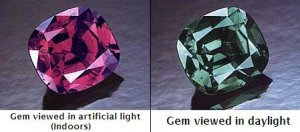- Joined
- Nov 21, 2002
- Messages
- 2,326
Alexandrite is considered a transparent gem which appears green in the daylight and red to purplish red in artificial light (indoors) . This phenomenon is known as color-change. Alexandrite is strongly trichroic (phenomenon of different colors appearing when viewed from 3 different directions)There are variables which affect the price of this gem including how dramatic the color change is, modifying colors, size, and location Alexandrites are found. When the color change is dramatic, the stone will be very expensive. Less expensive stones will have a weaker change and less saturated colors. The color phenomenon is a result of the presence of chromium ions and the way those ions are absorbed and reflected. The presence of brown or gray modifying colors will lower the value vs. the price per carat on alexandrites with the lack of these modifying colors. Alexandrite is more common in smaller sizes but still fetch a steep price tag due to the rarity of the gemstone and the current command in the market. Price on fine smaller stones range up to $10,000 per carat. There are large alexandrites which are very clean, but generally most stones have many inclusions including negative crystals & rutile silk. Ovals & cushion cut stones are the more common cut styles seen in the market. Alexandrite was originally discovered in Russia in the early 1830’s & this is where the finer top quality gem stones are found and command a premium. Russian stones are described as displaying color change from very green to dark cherry red. Some other sources of alexandrite include Ceylon & Brazil. Alexandrite is part of the chrysoberyl family. Some imitations or fakes include natural color change garnets & synthetic color change sapphires.
-Josh Rioux
Sitka, Alaska





300x240.png)